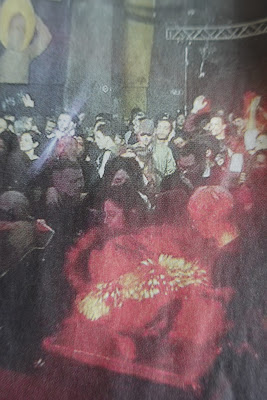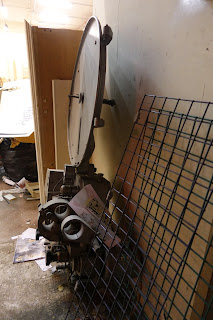 |
The building's entrance on via di Santa Croce in Gerusalemme. Note information boards on both sides. The banner
reads: "The right to housing is sacrosanct." |

It's an undistinguished building, to say the least. Despite its enormous footprint--occupying the end of a city block on the Esquilino, bounded by via Carlo Emmanuele, via Statilia, and via di Santa Croce in Gerusalemme (the latter a major thoroughfare running southeast off Piazza Vittorio Emanuele)--it is forgettable, pedestrian architecture of the sort that was all too common in the 1960s and 1970s.
 |
| "Read Scomodo" (a basement pillar) |
In this case, what matters is what's inside, and fortunately, the building's contents were at least partially suggested by information boards on the via Santa Croce side. One board revealed that there were all kinds of things going on inside: the ground floor housed a social service center, an afternoon school, and a "mini-basket" facility, where children could learn to play basketball; next floor up, an enoteca (wine shop), a wood-working facility, and something called the "spin beer lab." There's a theater on the 2nd floor and, on the 3rd, a religious center and a place to take lessons in the martial arts. From a personal friend, we also knew that the building housed the offices of "Scomodo" (meaning, roughly, "uncomfortable"), an excellent left-leaning, muck-raking magazine produced and distributed by young Romans, and now mainly online.
 |
Two of the information boards.
|
Another board provided some background. The building was once occupied by INPDAP (a government agency responsible for providing assistance to public employees), then for some years abandoned, before being "occupied"--that is, taken over, illegally and informally--in October 2013 by a group known as "ACTION," for housing purposes. The group began to reclaim some of the floors, went on a hunger strike--for what purpose remains unclear--and obviously (from the right information board), launched a variety of cooperative institutions and services that together constitute an effort to create an alternative community. There's even an osteria.
Today "ACTION" remains involved. However, as still another board explains, most everything is done under the auspices of the group "Spin Time Labs." The building is now home to 150 families (about 450 people), including immigrants, many of them once homeless or otherwise in need of a place to stay. And all this has happened in a building the occupants--whether the 150 families or Spin Time Labs--don't own.
Occupied buildings are common in Rome, and oddly (from an American perspective) tolerated--until they're not, which can be a long time. (
We wrote in 2011 about the occupation of a theater.) Covering the occupations, the newspaper
Il Messaggero noted that a building that once housed the Treasury Ministry was occupied for many years by the right-wing organization, CasaPound.
Il Messaggero seemed especially irritated that those occupying the buildings did not pay the appropriate fees.
Our first encounter with the structure was in mid-April, 2019. By mid-May, the building, and Spin Time Labs, were at the center of a major controversy. Neighbors of the building were upset--indeed, enraged--that the occupied structure was hosting loud, well-attended late-night (or all-night) parties, featuring a disco, drugs, and heavy drinking. It was impossible to sleep, they said, and in the morning the area was a mess: mounds of trash and hundreds of empty beer bottles.
 |
Late-night, nearly-morning revelers.
|
One of the most offensive of the parties, "Notte Scomoda," put on in December, 2018 by Scomodo magazine in their basement quarters, was visited by a number of motorcycles (there's a vehicle ramp leading downward, off via Carlo Emanuele), whose riders surely enjoyed revving their engines in that echo-y subterranean space.
 |
The ramp off via Carlo Emanuele
|
 |
| The legendary motorcycle party. Neighbors not in favor. |
 |
This could be the space used by the motorcycle rally.
|
Aside from the noise problem, the parties raised once again the issue of whether building occupations were and should be tolerated by the authorities. It was noted that Forte Prenestina had been occupied since 1986, and that another troublesome "entertainment" occupation, at "Strike spa" in Portonaccio (both farther from the city center), had been ongoing since 2002. (See our post
here, about Rome's issues with immigration and housing, and
here, about Rome "capital of evictions.")
Even the Vatican came in for censure. When Spin Time Labs failed to pay the building's electric bill, the electricity was cut off, then restored through the intercession of one Cardinal Krajewski (who has some sort of official church role in that area of Rome), who apparently did so on the grounds that there were 450 poor people depending on it. In addition,
Il Messaggero claimed that Spin Time Labs was exploiting the idea of helping those in need of housing in order to hold enormous social events and makes lots of money: thousands attending every weekend, each paying about $10 to enter, dance, and carouse.
If we read the information boards correctly, those involved in the occupation have long been interested in the re-use of materials, and with good reason. When INPDAP moved out, they left behind enormous amounts of stuff. We know this because when we visited the building--by invitation of our Scomodo friend--we were witness to the ongoing cleanup required to clear space for Scomodo's offices and social events.
 |
A basement area that needs to be cleaned up, contents sorted. Dianne is holding up a sign from one of the parties. Note that beer is more expensive than wine--the norm in Italy.
|
 |
A very old film projector.
|
Some rooms--including one (above) that resembles the newspaper photo featuring the motorcycles--have been emptied and cleaned.
Graffiti on the basement walls would suggest that housing remains a high priority for those occupying the building.
 |
"Too many people without houses. Too many houses without people."
|
 |
| Italy has some 50,000 people without housing, |
We've never been on the building's upper floors, never seen the osteria or the enoteca or the areas where families live. Maybe next year.
Bill
